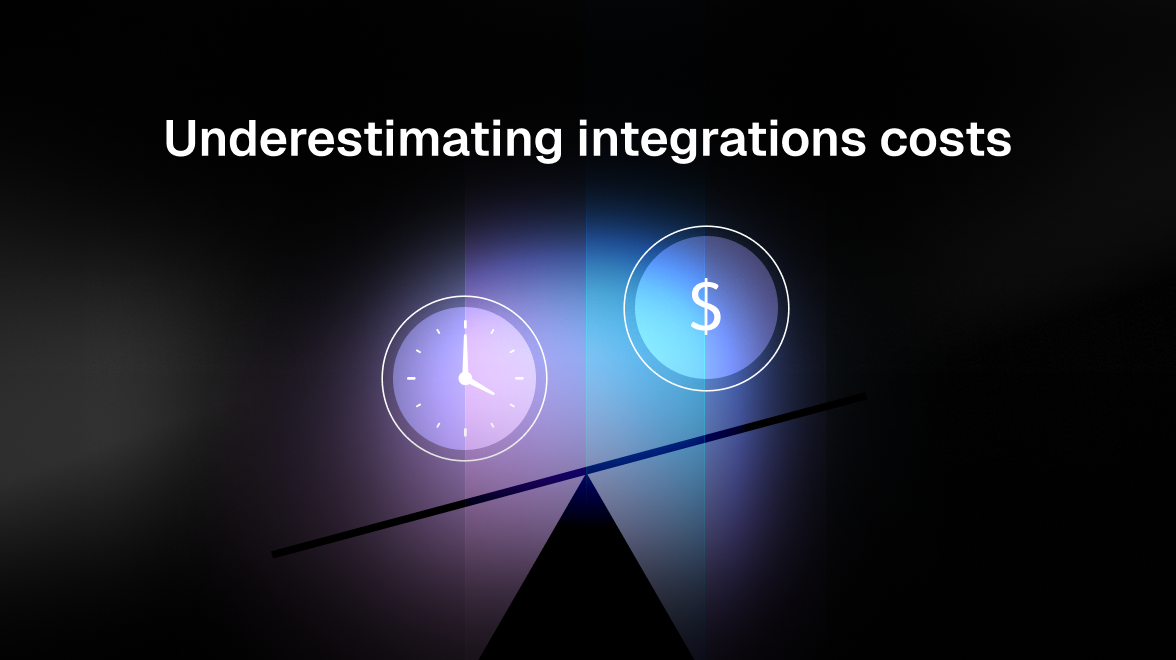How is Nango different from embedded iPaaS or other unified APIs?
Nango lets you ship integrations fast, without being constrained.
When it comes to integrations in SaaS products, there are two types of solutions:
- Embedded iPaaS: An embedded version of the popular low-code automation platforms
- Unified APIs: A single API for many product integrations
How does Nango, a unified API you can extend, compare to these categories?
Let's dive in!

Embedded iPaaS: Build integrations one by one, low-code
Embedded iPaaS are low-code platforms to build product integrations in B2B SaaS.
They grew out of automation platforms such as Zapier, Make/Integromat, Workato, etc.
Integrations are defined as workflows, and the platform has pre-built steps, with which you build your integration.
In practice, this approach has several drawbacks:
- Integrations need to be built one by one: Embedded iPaaS don't have a concept of unification. Every integration needs to be built from scratch.
- No pre-built use cases: The workflow steps cover things like "fetch customer by id" or "create contact". Use cases such as "sync all accounts from Salesforce" require several workflows and custom code.
- Pre-built steps are often limited: They only cover a small part of the external APIs.
- Low-code makes for a bad development experience: Visually programming integrations with linear workflows is cumbersome and slow for engineers.
Embedded iPaaS platforms have been around for many years, but are not popular with engineering teams building integrations.
In recent years, they have been outpaced by unified APIs.
Unified API: Pre-built integrations for limited use-cases
Unified APIs let you integrate once and access many integrations through a single API.
This simple concept has been popularized by companies such as Merge.dev.
Unified APIs offer several advantages over embedded iPaaS:
- Integrate once, support many integrations: Avoid building integrations one by one
- Pre-built use cases, instead of workflow steps: Unified APIs focus on pre-built use cases, such as "sync all accounts from Salesforce" or "update account X"
- End-to-end solution: Flip a toggle and the integration works. No additional workflows to set up API docs to study.
Unfortunately, traditional closed unified APIs, such as Merge, also have several drawbacks:
- Limited API coverage: Unified APIs only support certain categories of integrations, and only a limited number of APIs within these
- Limited access to data from the APIs: Because they unify the data model, pre-built unified APIs are limited to the common fields of the APIs they unify
- No possibility to extend or customize: If you need an API or use case the unified API does not support, you have to build it in-house yourself, working around the unified API
- Limited per-customer configuration: Advanced filtering, field mappings and configurations are often not possible with the unified API
- Limited visibility into integrations: Since they are managed entirely by the unified API, you cannot debug issues yourself and have to rely on their support
While unified APIs make it fast to ship integrations, we see most teams struggle with the limitations as they scale.

Nango: A comprehensive integrations platform
Nango is a comprehensive integratioins platform.
Like other unified APIs, Nango has a large pre-built catalogue of use cases. Our pre-built integrations handle 95%+ of the heavy lifting, so that you don't have to tackle the nuances of each API you want to work with.
You can also extend and customize integrations easily as if you're building integrations in-house. You can even build your own custom unified API on top of Nango's infrastructure.
All integrations, both pre-built and customized, are available through a single API.
This gives you several advantages over other, pre-built-only unified APIs:
- Future proof: With Nango you have full access to the API and build any integration your product needs
- Single API for unified and direct integrations: No in-house integrations infrastructure to build and maintain
- Best of both worlds: Use pre-built unified APIs where possible, build direct and custom integrations with key APIs of your customers
- Fastest growing catalogue: Since it is open source, Nango's catalogue of pre-built use cases and APIs expands fast
- Developer first DX: With end-to-end type safety and advanced tooling, Nango has been built from day one to make customization easy for engineers
- Full visibility into your integrations: Full access to logs, tracing and monitoring for all your integrations on Nango
Diving deeper
If you are curious to learn more about Nango, you can take a look at our website or sign up for a free account.
Want to dig deeper on different unified APIs? Check out our post on how to find the best unified API for your product integrations.
We hope this overview has helped you find the right approach for your customer facing integrations.
If you want personalized recommendations please feel free to join the Nango Slack community with 1,600+ engineers building integrations for their SaaS products.
The community will be happy to help you with tailored advice!
Useful resources
How to build integrations you and your customers love
Should you build or buy product integrations?






